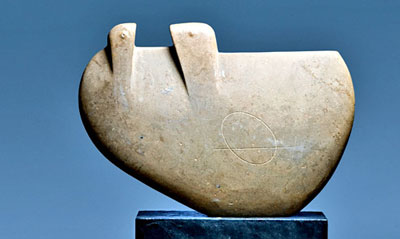
Sculpture News
A missing Henry Moore sculpture is the star at new Tate show - Great Britain |
| A good eye, scholarship and diplomacy have long been the vital weapons in any successful curator's armoury.
Now a major new exhibition at Tate Britain has suggested a fourth requirement for the modern practitioner: fluency in Google. An evening spent trawling the internet search engine turned up a sculpture that has never been shown before for the gallery's Henry Moore show, which opens tomorrow. The show seeks to overturn widely held perceptions about the artist and put sex, violence and radical politics back at the heart of the way Moore is perceived. In the 22 years since the artist's death familiarity with his work has bred something far more damaging than contempt: comfort.Moore's monumental sculptures are part of the national furniture, scattered across parks and public spaces all over the country. As a result they have become almost impossible to encounter as original artworks in their own right. So for Tate Britain's show to be worthwhile, Chris Stephens, the gallery's Head of Displays, felt that he needed to find less well-known works to go alongside all the famous reclining figures and mothers with child.  Without Chris Stephens... well this is where the story gets real intersting. Thank you Mr. Stephens! Below is a link to the Tate Britain site: Tate Britain Here is another Times Online article on Henry Moore titled "The skeletons in Henry Moore's closet" Among the works that Mr Stephens sought was a sculpture in brown hornton stone from 1936 that he found in a catalogue. It has apparently never been exhibited. Called simply Carving, it was last heard of in the collection of Martha Jackson, Jackson Pollock's dealer and one of the most important collectors of contemporary art in the mid-twentieth century. "I knew from a poor black-and-white photograph that it seemed to relate to other works quite close to it chronologically so I went looking for it," Mr Stephens said yesterday. He discovered that the Martha Jackson archive had been given to Buffalo University by her son but when he e-mailed the university all they could find was a photo of the sculpture with a name written on the back. "It was a pretty common New York Jewish name. It was too vague to use a phone directory - it wasn't quite Smith but it was Smithish. I spent an evening Googling the name and this woman came up who had been a benefactor of the Metropolitan Museum of Art and the Museum of Modern Art in New York. "I found her obituary and that led me to her son who was kind of in the public realm so I could send a message to his organisation. It turned out they had this sculpture. I don't know if they knew what they had but they replied saying 'Is this it?' with a photo that showed it next to their sofa." The family, who wish to remain anonymous, were not "people who know the ropes" of art exhibition lending but were sufficiently reassured by staff at one of the other American museums lending to the show to send the work to London. "It could have taken years to find it without e-mails or Google," Mr Stephens said. "But I like that kind of hunt. You could make a Moore show from the Henry Moore Foundation, the Tate and other museums' collections, but there were certain [other] things I was keen to find. Having a group of works that are closely related can reveal something that you wouldn't get if you just had one." In the case of Carving, a semi-circular structure with two horn-like outcrops detailed with bumps that could be "nipples or navels" and streaked with a network of lines, the new discovery provides clues to the figurative thinking behind another 1936 sculpture, Square Form, which belongs to the University of East Anglia and "is in every Moore show". Richard Calvocoressi, the highly respected director of the Henry Moore Foundation, said that the Tate show was "unquestionably" the most important exhibition on the artist in the foundation's 33-year lifetime. It includes all his most famous motifs and the celebrated drawings of poor Londoners sleeping in bomb shelters during the Blitz that made him a national figure. However, it also strips away the smooth edges of the wealthy establishment figure that Moore became. The show presents Moore as a passionate anti-fascist, a possible communist, a founder member of CND and a traumatised survivor of the First World War trenches who wrestled with a disturbing, erotically charged view of humanity. Although his class background made him reluctant to discuss his emotions, Mr Stephens believes that Moore's art reflected a "darker, more complex psyche" than the artist himself was willing to admit to. |
 "Carving" by Henry Moore |
More Sculpture ....
Submit your SCULPTURE NEWS.
It's easy, just send us an e-mail
(click on Submit News in the left menu) with your pertinent information along with images, we'll take care of the rest. Sculpture makes our world a much better place in so many ways!
SculptSite.com, along with Sculptors and their creative genius all helping to bring the beauty and message of Sculpture to a hurried world.

